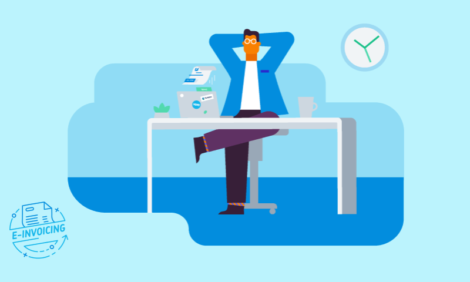
The top myths about eInvoicing, busted

Is eInvoicing on your radar? This new way to manage invoicing holds huge promise for the 90 per cent of Australian small businesses that still send PDF or paper invoices. Why’s that? Well, it’s not only faster, but a more efficient and secure way to manage invoices and bills. But there are still many misconceptions holding people back from seeing these benefits. Which is why it’s time to take a deeper look at the biggest eInvoicing myths.
1. Sending an eInvoice is the same as sending a PDF or using accounting software
Nearly half (47%) of small businesses surveyed in Xero research last year incorrectly defined eInvoicing as sending a PDF of the invoice or sending a link to the invoice via email. Yes, while many small businesses may already be using an electronic way to send and receive invoices, this is actually different to eInvoicing.
Instead, eInvoicing is a way to exchange invoices directly between accounting software. This means instead of having to be PDFed and emailed, invoices will automatically show up as a draft bill waiting to be approved and paid in Xero – saving you precious time on manual data entry.
2. My business is too small to need eInvoicing
The good news is that eInvoicing is relevant for all businesses that send and receive invoices, large or small. One of the big benefits is that it allows smaller businesses to easily work with enterprises and government agencies.
Traditionally, large buyers have forced smaller suppliers to deliver electronic invoices via expensive and clunky custom-built systems (usually at a major implementation cost to the supplier). This pretty much locks small businesses out of the equation as they simply can’t afford to meet these requirements. eInvoicing changes this completely. It means everyone, large or small, uses the same network – removing these barriers.
3. I don’t send or receive enough invoices for eInvoicing to make a difference
You might be surprised to learn that each time an eInvoice replaces a PDF or paper invoice it can save up to $20 for those involved. Even if you only send or receive a few invoices a month, the time savings can add up fast. Since eInvoicing is also more secure than sending via paper or PDF, it reduces the risk of foul play and helps make sure your invoice ends up where it’s meant to go. Since eInvoicing is already included in your Xero subscription, there’s no extra costs or new software needed.
4. eInvoicing isn’t relevant to me since I only receive invoices, rather than send them
eInvoicing offers benefits at every step of the journey – yes, even if you only receive bills (or vice versa). When receiving bills, it saves time and manual data entry since eInvoices automatically flow into Xero. Rather than having to sift through emails and input details, they instead show up as a draft bill waiting to be approved and paid.
It’s quick, easy and free to register to review eInvoices in Xero. Simply follow the steps here to ensure you’re good to go.
5. I can’t use eInvoicing because my customer isn’t using Xero
One of the best things about eInvoicing is that it is platform agnostic. What this means is that it doesn’t matter which accounting software you or your client uses, as long as it’s a certified Peppol access point or can provide access through one. Peppol is a network custom-built for eInvoicing, with extra security and protections to help invoices travel safely to their destination. Peppol is a little like sending an email – it doesn’t matter whether you’re using Gmail or Outlook; both the sender and receiver need an email address for it to work.
6. The ATO is spying on my business activity through eInvoicing
Don’t worry, no one is looking at your eInvoices who shouldn’t be. In Australia, the ATO is responsible for managing the Peppol network and enabling businesses and governments to access eInvoicing. This is a natural extension of its other systems and responsibilities when it comes to supporting Australian businesses.
However, this doesn’t mean the ATO has access to any of the information shared via the Peppol network. You can rest assured that your eInvoices are only being seen by their intended recipients.
7. I am a B2C business so eInvoicing doesn’t apply to me
Whilst you may not be able to invoice your customers via eInvoicing, you can still reap the benefits of eInvoicing by registering to receive eInvoices from businesses who invoice you. This will save you time manually entering or scanning bills into Xero.
8. eInvoicing will cost me extra
Consider this myth busted! eInvoicing is included as part of our standard Xero offering. Getting started takes only a few simple steps – take a look here for more details.
The post The top myths about eInvoicing, busted appeared first on Xero Blog.
Source: Xero Blog






